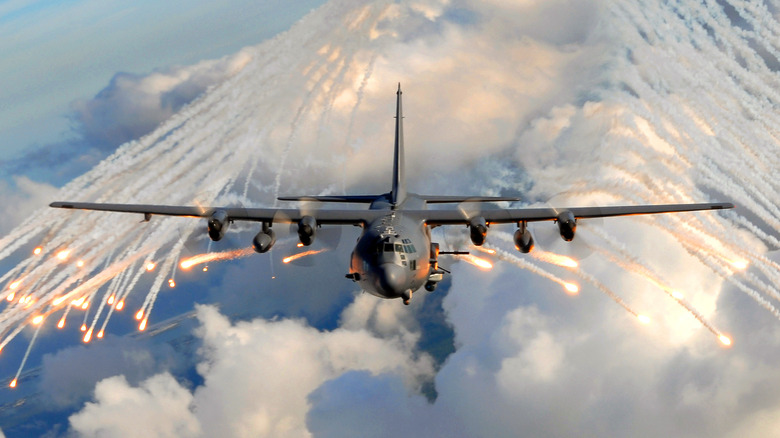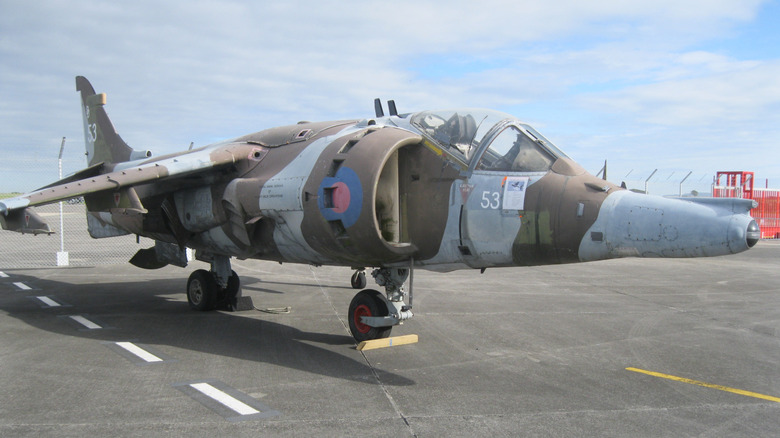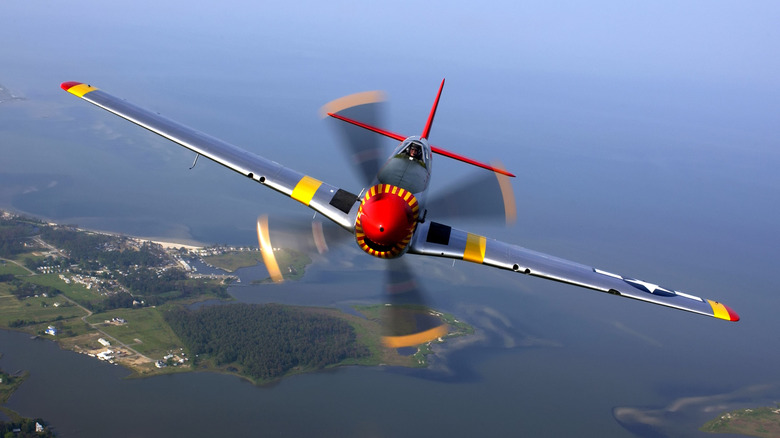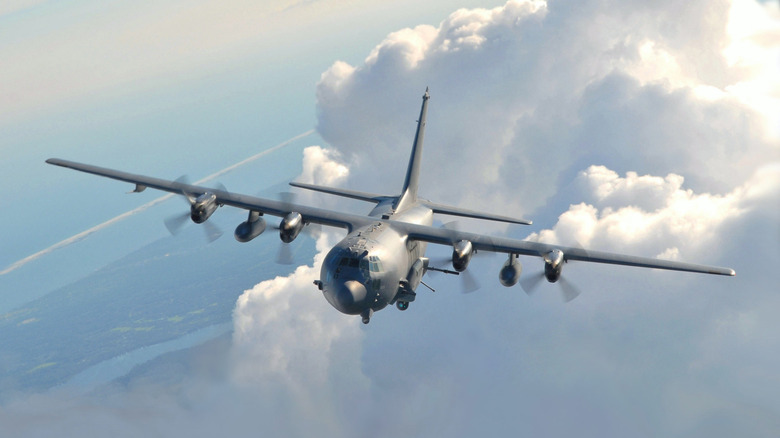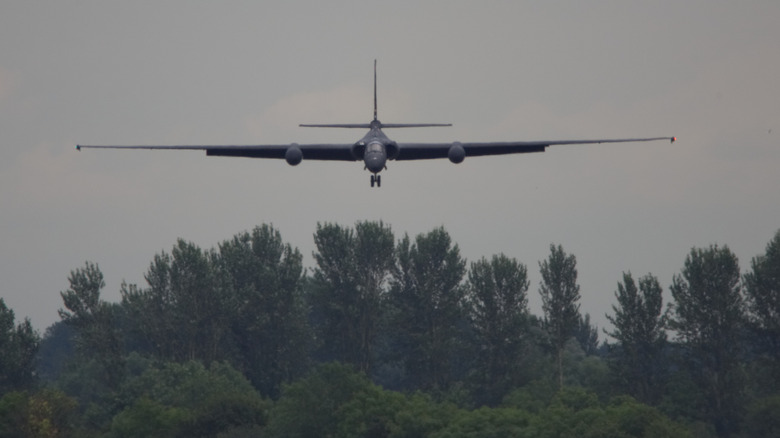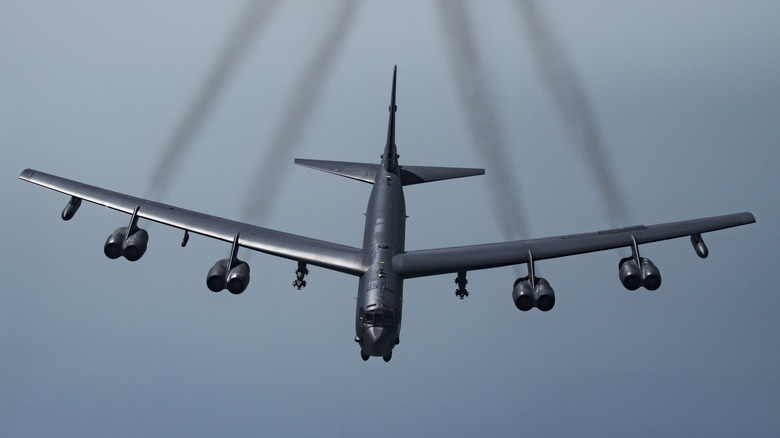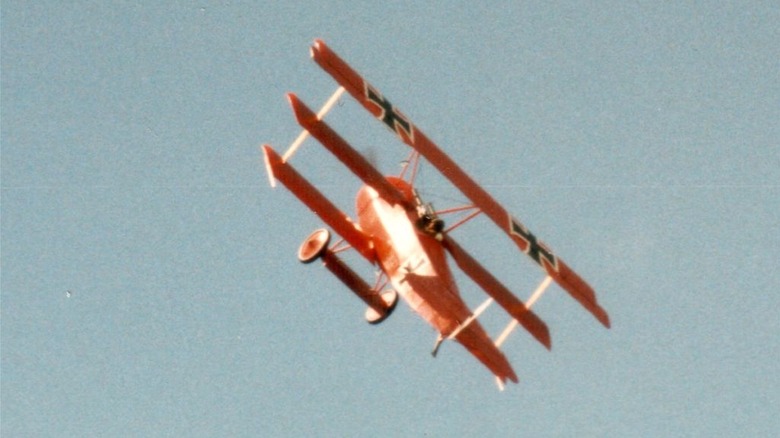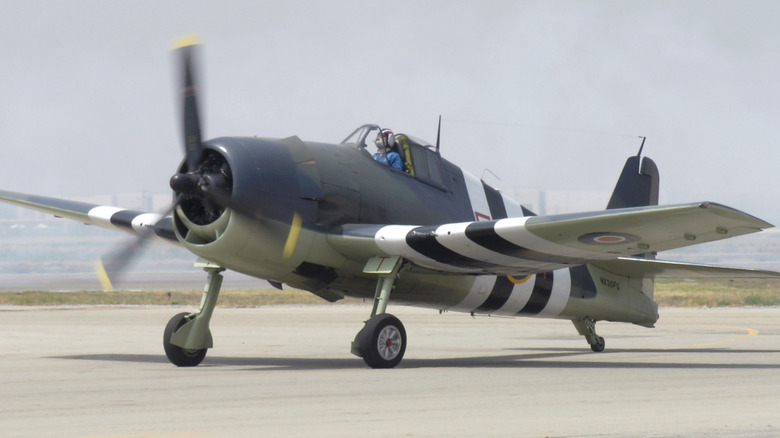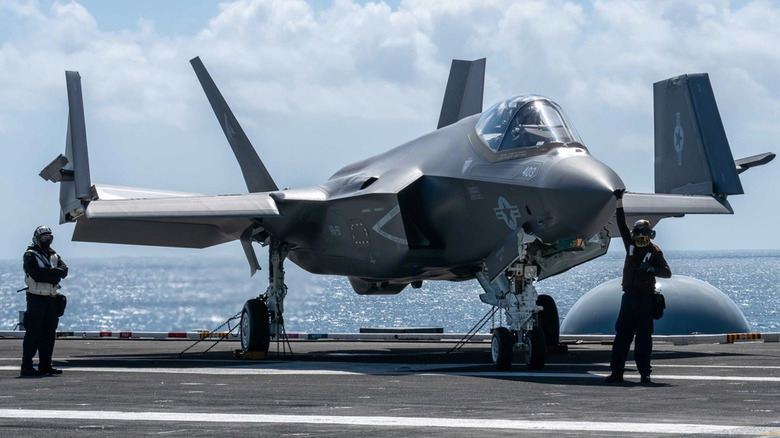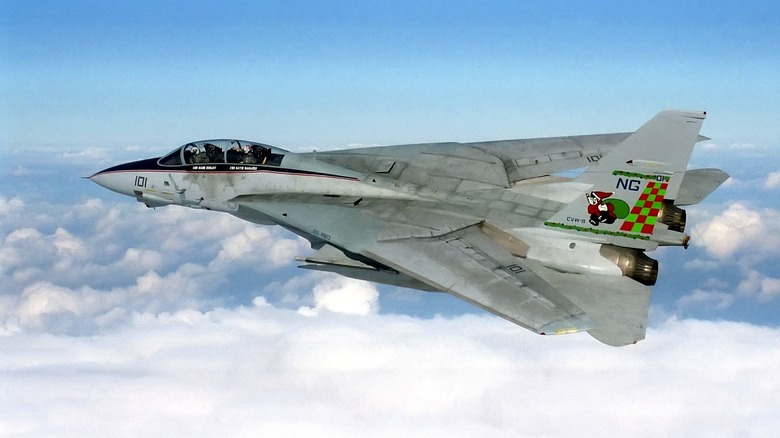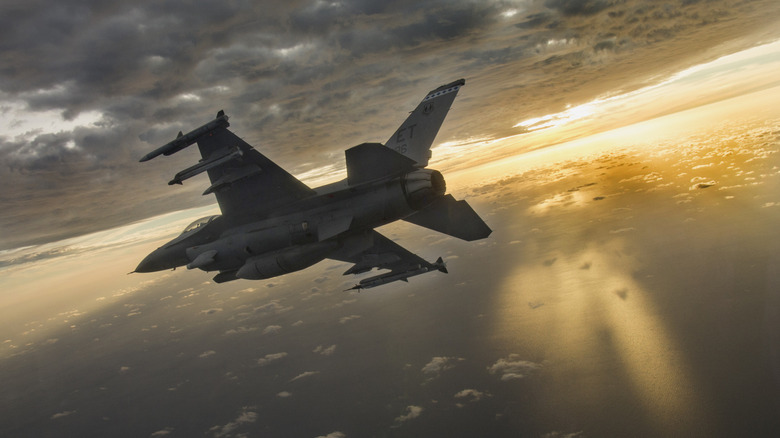10 Of The Most Famous Warplanes In History
Modern sensibilities see wars fought on three fronts: land, sea, and air. Tanks and ground infantry lead the charge on the ground, ships carry equipment across the sea and serve as mobile bases for jet fighters, which dominate the skies, softening the enemy with bombing runs and shooting down missiles. Of course, there's a whole lot more to the science of warfare than that, but it's a decent enough place to start. For this list, we're looking to the skies and shining a spotlight on some of the most famous aerial vehicles ever to fly during a time of war, spanning from the early days of flight during World War I to today's most high-tech jets.
The aircraft on this list are iconic for their appearance, utility during times of crisis, and pilots who performed outstanding feats of derring-do that would become the stuff of legend, inspiring wartime folklore and boosting morale for their side of the conflict. Read on to learn more about 10 of the most famous warplanes in history.
Harrier Jump Jet
This British plane spent more than a decade in the R&D and prototyping phase before making its first official flight in 1966, though it didn't actually see action until the Falklands War of 1982. The Harrier is called a jump jet because of its special ability to achieve flight vertically, lifting directly off the ground like a helicopter instead of requiring the length of an entire runway to reach takeoff velocity like traditional jets. It also had the ability to hover for limited periods. However, it was seldom used in actual combat situations and was often derided as little more than a marketing gimmick or an extra tool for the Harrier to utilize for an advantage.
During its manufacturing lifetime from 1969 through to 2003, over 800 Harriers were delivered to air forces around the world, including Italy, Spain, and the United States. Today, the only country that still uses the Harrier is Spain, which decided to keep them in service as a cost-saving measure. They decided it was better to keep using the older jets than upgrading to a prohibitively expensive replacement like the F-35.
P-51 Mustang
World War II brought incredible innovation to all forms of warfare. It was also the war in which battleship combat was usurped by aerial skirmishes launched from aircraft carriers, effectively making air and sea combat one and the same, at least in the Pacific Theater, with its focus on naval warfare. The P-51 Mustang is one of the most ubiquitous Allied combat planes of the WWII era, and saw action against the Japanese Empire, German Nazis, and Italian fascists across virtually all of the war's many fronts. It would be upgraded numerous times during the war; By 1944, Allied pilots went from flying the original P-51 Mustang to the P-51D, which was armed with six .50-caliber machine guns (up from four on the previous model) and a redesigned canopy that gave greater visibility to the pilot.
The plane also became known for its association with the Tuskegee Airmen, a primarily Black fighter group with an impeccable combat record during the Second World War. They would paint the tails of their Mustangs a distinctive red hue, earning them the nickname Red Tails. The Tuskegee Airmen, who fought Nazis in the air and institutionalized racism on the ground, would become immortal thanks to numerous documentaries and feature films made about their exploits, including 1945's "Wings For This Man," narrated by Ronald Reagan, and 2012's "Red Tails," a George Lucas-produced action movie that would be the final film released by an independent LucasFilm before its purchase by Disney.
AC-130
The C-130 Hercules was developed as a troop transport in the 1950s. It was notable for its sheer size and ability to take off from ad hoc runways on makeshift military bases. Eventually, the geniuses at Lockheed asked the question: "Hey, what if we put guns on it?" And thus, the AC-130 was born. First put into service in 1968 during the height of the Vietnam War, the AC-130 cast a long shadow, literally and metaphorically, with its imposing figure and ability to rain death on enemy forces from thousands of feet in the sky. The AC-130 has been improved many times over the years and is still in use to this day, as is the decidedly lesser-equipped C-130.
Video game enthusiasts know the AC-130 for its use in the controversial "Death From Above" mission in 2007's "Call of Duty 4: Modern Warfare", which places the player character behind the guns of an AC-130, viewing the carnage through a thermal camera, with the in-game imagery evoking real-life news footage of various wars in the modern era.
U-2
When people think of U-2 ... well, they probably think of the rock band, U2. But the other U-2 is the world-famous spy plane, and one of the oldest still in service. The original U-2 was developed by the CIA in clandestine partnership with the U.S. Air Force in an attempt to get a leg up on the Soviet Union, with its first surveillance missions taking place in 1956. The idea was that if the plane flew high enough, it could evade Soviet tracking. Unfortunately, it didn't work.
In 1960, CIA pilot Francis Gary Powers was flying his U-2 over Soviet airspace, on a mission to photograph Soviet territory, when he was shot down and captured, exposing the USA's spy program. Powers spent 21 months in a Soviet prison before being returned to the United States in a prisoner exchange. The whole incident was an embarrassment to the administration of President Eisenhower. It escalated Cold War tensions in the early 1960s, contributing to the tensions surrounding the Cuban Missile Crisis, which nearly brought about the end of the world.
As for the U-2, it continued to be used in the Vietnam War for reconnaissance missions and has undergone substantial upgrades since then. Today, it is used in missions surveilling the US/Mexico border, as well as the infamous 2023 Chinese Balloon Incident.
B-52
When you think about the B-52, the first thing that comes to mind is the Love Shack band ... wait, did we do this already? Nevermind.
Like the U-2, the B-52 Stratofortress is one of the longest-serving planes in the Air Force, having first been introduced in 1955. Its status as a fortress comes from its size and self-sufficiency. The idea was to create a bomber that didn't require support aircraft and could defend itself with its own turret gunners on its way to and from a bombing target. Indeed, thanks to its service in the Vietnam War, the B-52 became the largest ship with credible air-to-air victories on its combat record.
The B-52 was also an integral part of Operation Chrome Dome, a mission to keep nuclear-equipped bombers in the sky and ready to attack Soviet targets at a moment's notice. Unfortunately, thanks to multiple unfortunate accidents, the project ended up causing more trouble than it was worth, and was ultimately retired as ICBM silos took the place of bomber aircraft as part of America's nuclear strategy. Nevertheless, the B-52 continued to see use as the years wore on, including the first Gulf War, Operation Enduring Freedom, and Operation Iraqi Freedom, and was used against the Taliban as recently as 2021.
Fokker Dr.I
If there's a single most infamous pilot in the history of aerial warfare, it has to be Manfred von Richthofen, better known around the world (and to Peanuts/Royal Guardsman enthusiasts) as "The Red Baron." He is credited with taking down 80 enemy fighters during World War I, but his aristocratic sense of honor and sheer skill earned him the respect of even his enemies. His autobiography, the title of which translates to "Red BattleFighter," was published in 1917, just one year before he died in battle in April of 2018 in the skies over France, six months shy of the war's end. He was 25 years old. He was given a full military funeral by the Allied forces. On one of his funeral wreaths read the phrase, "To our gallant and worthy foe."
Though he flew several different planes during the war, his most famous was the Fokker Dr.I, or the Fokker Triplane, as it was known, due to its unorthodox trio of wings. Richthofen spent the last period of his career in this triplane, scoring 19 victories with it (including two in a prototype version) before dying in its cockpit. The plane was slower than its contemporaries, particularly those used by the British fighters, but it was agile and maneuverable, like a leaf on the wind, so to speak. Ultimately, Germany lost the war, but the legacy of the Red Baron remains legendary among aviation enthusiasts the world over.
F6F Hellcat
When the United States entered World War II, its main fighter plane was the Brewster F2A Buffalo, which was soundly rejected by pilots as akin to a flying coffin. Quickly, the Buffalo was replaced with the F4F Wildcat, which, while an improvement over the Buffalo, was still inferior to the Mitsubishi Zeros used by the Japanese forces. Fortunately, the third time was the charm, and the F6F Hellcat, with its 2,000 HP Double Wasp engine, helped to turn the tide of aerial combat against the Empire's Zeros. Eventually, the Japanese were able to develop the Kawanishi N1K-J Shiden to compete, but by the time it saw action in late 1944, it was too late, and the tide of the war could not be reversed.
Over the course of two years, over 12,000 Hellcats were produced by the United States. The planes had a maximum speed of over 370 MPH and were armed with six .50-caliber machine guns, in addition to having both rocket and bombing capabilities. Following the end of World War II and the development of far more advanced fighter planes, the Hellcat was quietly retired, with many of the planes used as target drones controlled via radio signals for training exercises. This marked an unceremonious end to a piece of equipment that had helped save the Allies from defeat in the Pacific Theater.
F-35
America's modern jet fighter is the Lockheed Martin F-35 Lightning II, the ultimate one-man fighter for today's high-tech military. A deeply complex feat of engineering, firepower, and computer-assisted operation, each F-35 costs about $100 million to produce, to say nothing of the cost of years of R&D, pilot training, additional equipment, and maintenance. Yeah, the controversial program is basically a money pit.
Though the F-35 had its first test flight in 2006, it didn't enter active service in the United States military until 2015. In fact, the United States wasn't even the first country to use the F-35 in combat. That distinction goes to Israel, which used the F-35 to attack Iranian targets in Syria back in May of 2018. America didn't use the F-35 in combat until April of 2019, when the jets were used to strike at ISIS forces in Iraq. Up to that point, the F-35 was more well-known for its appearances in movies like "Live Free or Die Hard", in which it utilizes its vertical hover mode and a few other ineffectual tricks before being destroyed by hero, John McClane, played by Bruce Willis. If there's one person who can single-handedly take on an F-35 jet, it's Bruce Willis.
F-14
Perhaps the most famous jet fighter of them all, the F-14 is best known as the plane from "Top Gun". Its use in that film was so iconic that the filmmakers even contrived a way to have it return in "Top Gun: Maverick", a sequel produced 36 years later. Thanks to the enduring popularity of the film, when one thinks of a fighter jet, they are likely visualizing an F-14 Tomcat.
The F-14 was developed during the Vietnam War in the late 1960s and early 1970s, but it saw limited use during the war, mostly as escorts during the American withdrawal from Saigon known as Operation Frequent Wind. The F-14 didn't truly earn its combat stripes until 1981, when a pair of F-14s downed two Libyan MiGs in what would be known as the Gulf of Sidra Incident. The F-14 would go on to see use in America's War on Terror in the Middle East before being retired from service in 2006. One other country to utilize the F-14 was Iran, which used them extensively during the Iran-Iraq War of the 1980s, back when Iran was considered an American ally.
F-16
The F-16 was developed in the wake of the Vietnam War, quickly became the preeminent jet fighter of the United States, and was ultimately adopted by the Air Forces of over 20 other countries. It's a tremendously popular plane, with over 2,000 F-16s in operation today. Originally intended to be replaced by the aforementioned F-35 jet, a replacement that is still in the cards, the Air Force nonetheless doubled down on the F-16, opting to keep the tried-and-true fighter in service for at least two more decades while they continue to work out the kinks in the F-35 program.
In a testament to the enduring superiority of the F-16, the jet is being used on a daily basis to save lives in Ukraine during Russia's senseless war. On December 13, 2024, a Ukrainian pilot scored an unprecedented victory, making history in the process, when he shot down six Russian missiles in a single sortie, saving countless lives and boosting morale, all while proving the necessity for these F-16 jets in protecting Ukraine from Russia's campaign against the people of Ukraine.
